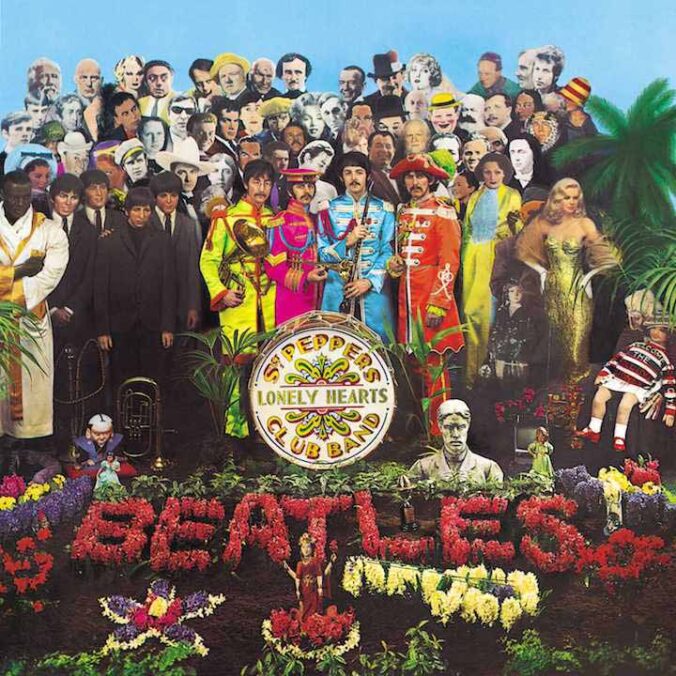BRIEF
For this project, you will design the cover artwork for an album by a (fictional) band with randomly generated and assigned name. Since the band is fictional, you get to decide what genre of music they play and what their visual style is – the randomly-assigned name is just a guide. You will assemble the composition in Adobe Photoshop and/or Illustrator using found images (photos/graphics taken from books, magazines, etc.) cut from the materials provided; you may also incorporate images from your own materials and/or take new photos to use in the project. Your final product will be an album cover exported as a high-quality PNG for Apple Music (4000 x 4000px), and printed/mounted at 10″ x 10″ (a standard LP size).
BACKGROUND
A photomontage is a collage work that uses cut (or torn) photographic images as graphic elements, often with simple solid-color background or geometric shapes. The style originated with Dada artists in 1910s – 20s Germany, was adopted by Constructivist designers in the early USSR, and then mainstreamed by the Bauhaus school before becoming ubiquitous in Pop Art and commercial graphic design like advertising and packaging.
PROCESS
STEP 1: IDENTITY
- Draw a random band name from the bag in class – I will assign the remaining names at random to absent students.
- Brainstorm a genre and identity for your band – “identity” encompasses the style of music, presentation, and (fictional) history of the band. Is it a solo artist or group? Are they new or established? Indie or major-label? Where do they usually perform, and what are the performances like? Do they use any special instruments, costumes, or stage equipment?
- (In Class) Present your band’s name and identity, and describe the general aesthetic (look) you’re going for.
- (Homework) Make rough drafts of 5 original type treatments for your band, upload and post to OpenLab – post under the categories “Project 4: Album Art” and “Step 1: Identity”. A type treatment is the specific fonts, scaling and positioning used to graphically present written words.
STEP 2: SOURCING IMAGES
- Gather images for compositing – browse the materials provided and collect images that relate to your band’s aesthetic. These can be images you want to use in the project, but you should also collect images that relate to the look/feel you’re imagining just for reference. You may also use images from your own sources (magazines, books, etc.) and/or your own photographs.
- Cut out figures/objects from images – use selection tools and layer masks in Adobe Photoshop to isolate (cut out) the figures you want to use from your scanned collection. Save these cutout images in PSD (PhotoShop Document) format, to use in the next step.
STEP 3: DRAFTS AND REFINEMENT
- Make draft comps in Photoshop for 4 potential layouts (4000 x 4000px) – use Adobe Photoshop to make rough drafts of four different layouts by placing and arranging your cutout images and/or solid-color geometries. Integrate your type treatment into the design – it should be clear and legible, but does not have to be the primary/focal element of the composition.
- Refine your top design from the previous step into a final comp – final comps are still drafts, but they should reflect the final layout and position, have precise selections and masks around cutout layers, and incorporate all other graphic elements.
STEP 4: FINAL VERSION
- Create a polished, final version of your album art based on feedback from the previous steps.
- Export your finished project and upload to OpenLab – PNG format (File -> Export -> Save for Web (Legacy)), saved using the PNG-24 preset
STEP 5: PRINT AND MOUNT
- Create an Adobe InDesign document at 10″ x 10″ with a 1/8″ bleed.
- Place your album cover in the document, scaling to fill the entire space (including bleed area).
- Export as a PDF using the “High Quality Print” preset. Make sure “all printers’ marks” is checked in the dialog box.
- Print on tabloid (11″ x 17″) stock, at least 90lbs in weight.
- Mount to a piece of black presentation board or foamcore cut to 15″ x 15″ (2.5″ margin on all sides).
SCHEDULE & DUE DATES
3/28 (Tuesday) – draft identity due
4/4 (Tuesday) – four draft comps due; last class before spring break
4/14 (Friday) – project due, review and critique
EXAMPLES OF STUDENT WORK

Darcy Castro

Yamil Gil

Vivian Li




